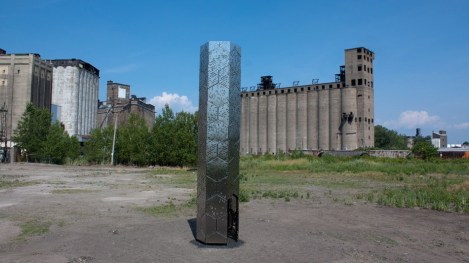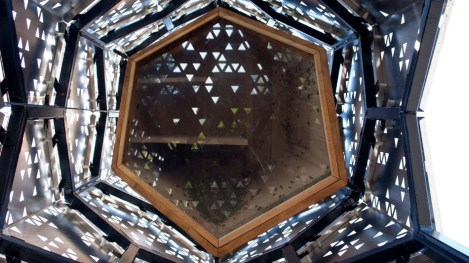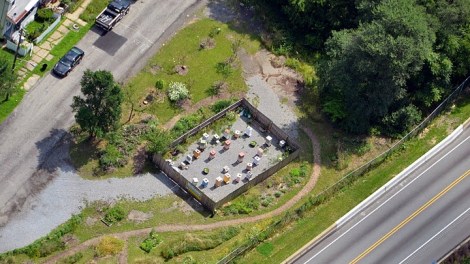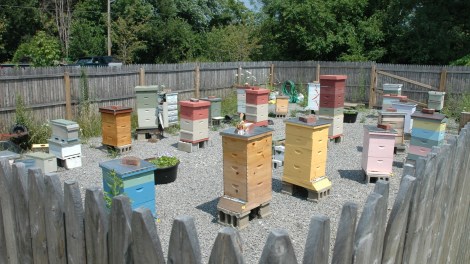Deep in the defunct industrial zones and backyards of Buffalo, N.Y., there’s a buzz developing — quite literally, in the form of secret beehives. Across the city, a small network of under-the-radar beekeepers has formed. They keep hives in backyards, vacant lots, and even on garage roofs.
“Two years ago, I was just kind of wandering around one of the smaller, cottage neighborhoods that we have here, and I noticed one woman with all this bee art covering her garage,” says Alexandra Farrington, a beekeeper in Buffalo. “I asked her if she kept bees. First she asked if I was a cop, and then she said, ‘Well, if you promise not to tell … yeah, I’ve got a few hives on the roof of my garage.’”
While Buffalo has no laws explicitly banning the practice of beekeeping, many neighbors view the critters as a public nuisance. Keepers worry that enough complaints might add up to local legislation that would prohibit beekeeping or severely regulate it. “That’s usually how things go,” Farrington says. “People start to complain, and then the laws are revised and regulations are put into place.”
Farrington and her fellow Buffalonians aren’t alone. In cities across the United States, more and more urbanites are taking it upon themselves to create habitats for bees. Urban beekeeping is not only a crucial component of a city dweller’s fully functional homestead — offering both fresh honey and crop pollination — it’s also a response to growing concerns over colony collapse (just this month, the New York Times reported that commercial beekeepers are losing roughly a third of their colonies each year). As the urban beekeeping trend grows, so does the rift between well-intentioned, hyperlocal food producers and neighbors who aren’t down with all the buzz.
“The way that urban beekeeping currently operates is that the beehives are quite hidden. And it’s not because they need to be — it’s just because people are uncomfortable with the idea,” says Noah Wilson-Rich, bee scientist and founder of The Best Bees Company, in a 2012 TEDxBoston talk on bees’ role in urban food systems.
But as Wilson-Rich notes, “We need bees for the future of our cities and urban living.” Buffalo might seem an unlikely site for a bee renaissance. But the post-industrial city first gained notoriety among apiphiles two years ago, when architecture students from the University of Buffalo received substantial media coverage and international acclaim — including an AZ Award for Design Excellence — for designing and constructing a 22-foot steel structure to house bees. Elevator B, as it’s called, is located in Buffalo’s Silo City. The cluster of abandoned grain silos stand as a testament to the city’s past as a hub for industry and agriculture. Elevator B was opened to much local excitement in May 2012, and the bees were moved in — but not for long.

Hive City Elevator B was constructed in 2011 in Silo City, a cluster of abandoned grain elevators in Buffalo that are now being repurposed.
“It’s very beautiful, and really cool,” says Farrington. “But it was created as an architectural project first, and not primarily as a habitat for bees. The bees only lived there for about a year because it wasn’t sealed up properly, and the space was a little too big and drafty for them.”

Hive CityThe interior of Elevator B.
Two years after the initial opening, however, Farrington is working with architecture students to make renovations to Elevator B so that it functions as a comfy home for a colony to build comb in peace. Farrington tells me that Elevator B played a significant role in stimulating a city-wide interest in beekeeping, and creating the network of beekeepers that exists today:
“People would come and visit the [site], and ask, ‘Oh, how can I get a hive at my house?’ or ‘How can I help the bees?’ So I started drawing a lot of connections to who was keeping bees in the city, and how we could form a sort of bee network where we could talk and exchange materials if we needed to, or just knowledge.”
As a city, Buffalo has some characteristics that are beneficial for undercover beekeeping. It has a wealth of abandoned industrial zones and vacant lots, as well as lower-rent areas where police patrols are noticeably sparse. Farrington also suggests that neighborhoods with large immigrant populations are more accepting of beekeeping, because it’s a more common practice in other countries.
I ask Farrington what it might look like if backyard beekeeping were scaled up around the city, and she lights up.
“Oh, I think that would be amazing! I think more and more people are starting to keep small kitchen gardens in their backyards, and are taking more and more responsibility for what they eat and where it comes from,” she says. “And we’ve got more urban farming going on — we’ve got greenhouses all over Buffalo, some that are state-funded. If we could have those pollinated and have them going all year round, it would be pretty amazing what we could actually get just from our local food system.”
Buffalo might look to Pittsburgh, another Rust Belt beekeeping outpost, for a little advice on scaling up. In 2010, Burgh Bees established a community apiary in the neighborhood of Homewood. I spoke with Steve Repasky, president of Burgh Bees, who tells me that he believes it’s the first one of its kind in the country.

Burgh BeesThe Burgh Bees Community Apiary in Pittsburgh, Penn., was established in the neighborhood of Homewood in 2010.
“So basically it operates on the same format as a community garden, where you have a certain amount of spaces for hives,” Repasky says. “It’s worked out well — people are able to manage their hives, able to get honey, and they’re able to partake in educational opportunities with others interested in the whole beekeeping world.”
Burgh Bees has trained over 450 beekeepers in the past five years. They host four beekeeping classes a year — three beginners’ classes, one advanced — and they are consistently filled to capacity.
Burgh Bees has also worked with Pittsburgh’s city government to develop a set of beekeeping laws. The language of the ordinance is written very much in beekeepers’ favor, but the process of obtaining a permit to keep bees on private property presents some obstacles. The application costs $275, and anyone seeking a permit must argue their case for wanting to keep bees to a zoning board. The hearings are public, and anyone has the right to appear and argue against having a hive in the neighborhood. Even if the permit is denied, the cost of the application is non-refundable. This has prevented many people from seeking legal beekeeping permits in the city.
“The official stance of Burgh Bees at this point is to not apply for the permit, but rather just talk to your neighbors,” Repasky says. “And if your neighbors directly around you are OK with it, then OK, keep bees. But if you get caught, then you have to go through the process.”
Repasky and the rest of the organization are working to get the permit process revised so that costs aren’t as prohibitive. In the meantime, the community apiary offers a way for Pittsburghers to keep bees without worrying about city regulations.

Burgh BeesThe Burgh Bees Community Apiary.
So what could bring the hives out of hiding in Buffalo? Ideally — as Burgh Bees did — getting some laws on the books that would protect and support beekeepers without enforcing prohibitive regulations. There’s always the possibility, however, that any efforts in that direction would provoke a counter campaign from those who believe that keeping bees in cities is a threat to public health. When one considers the fears of a parent whose child is allergic to bees, for example, that threat isn’t necessarily negligible.
Having a means to share knowledge and experience is an essential part of maintaining a local network, too. Farrington says beekeeping expertise tends to be found primarily in rural areas. The Western New York Beekeepers’ Association covers a region that includes Buffalo, but meetings are held far outside of the city.
Farrington is planning on moving a colony of bees back into the renovated Elevator B next month. Even once the bees are back in action, the structure won’t be used for honey harvesting, unless the bees build to the point where they need more space. Its primary purpose will be to serve as a means for the people of Buffalo to learn more about bees, how they work, and why they’re so important to food systems.
And in Pittsburgh, Burgh Bees is responding to the overwhelming interest in beekeeping by working on opening two more community apiaries in other neighborhoods in the city.
“[The enthusiasm] is constant,” says Repasky. “We have to keep adding classes because people really want to learn about honeybees and how to keep them. And we’re here to do that. Our mission is to promote beekeeping as a vital part of sustainable agriculture — and we’re actually doing it! That’s what’s so exciting.”



